Getting ready for your new solar system
Talking about solar systems is like talking about computers; everyone has an opinion and it all depends on what you do with them. So rather than getting into the technical details of solar systems, which you can find all over the internet already, I'm going to share how to get ready for them, how to use them and how to live with them!
Prepare for change
The statistics state that in 2015 the average US household consumed 901KWh of electricity per month (30KWh per day). When we lived in St. Albert we were hitting 660KWh per month (22KWh / day). When we priced out the cost of solar systems over 10 years ago, it was VERY expensive to build an array that would provide us with that much power in a month. To put this into perspective, 901KWh is 901,000 watts or the equivalent of running a single 100W light bulb for 9010 hours or a 1500W hair drier for 60 hours straight! That is a lot of power. Today, the costs are dropping, but that should not stop us from going through the exercise of reducing our consumption first.
When living off grid, my goal was to find ways to live within the means of what nature and I could provide, to not demanding anything from her. There is a reason why the utility companies called it 'power demand'. When you turn on your stove, hair drier or lights, you are demanding power from the utility company and they are under contract to provide. They will do that despite all the pollution and electromagnetic radiation they produce to accomplish that goal. I did not want to demand anything from nature or anybody else for that matter.
The first step was to figure out how big my system should be. We resolved ourselves to the idea that we would forgo the electric stove, cloths dryer, and dish washer, microwaves and anything like that. Instead we went with a gas range, Sunfrost fridge and we then built a solar and wind power cloths dryer (yes, we put up a cloths line). We still run computers obviously, TV, lights, washing machine, food processors, vacuum cleaner and even a hair dryer. But now we really have to watch when we use them. If the sun is out and the batteries are full, then we got to work. If not, then we found something else to do that did not require electricity.
Over the first four years our solar system was running, I kept track of the power generated from our system. On average we consumed 5KWh of electricity per day / 150KWh per month. About 20% of that power was lost due to the costs of running the system, batteries, etc. So our actual power usage is around 4KWh per day / 120KWh per month, which is an 82% reduction from when we lived in the city and a 87% reduction from the US average. That is a significant reduction in power usage. Obviously the majority of the power was used in the summer time and very little in the winter as you can see from the graph.
We accomplished this goal by learning how to live within the cycles of nature. If it is a sunny day, then we have the power to run a washing machine, vacuum cleaner or even air compressors, saws, drills and other tools. That is especially true during the summer time. However in the winter, there is no way we can run all those things. So we put the deep freeze outside in a shed. That way Mother Nature can keep our food frozen without any demands on our system. In the summer we have lots of power, so no problem running the deep freeze. We don't run all the extra tools as it would be too much for our system to handle. We built an earthship so that the summers were cooler without having to run an air conditioner. In the winter we heat with wood, so no electricity required for a furnace. You heard me right, we have no furnace in our home!
After a few years of living this way, we found ourselves resting, relaxing and contemplating the coming season during the winter time. Winter ended up being our rest period, which is the complete opposite of the industrial system we came from.
But with all that said, we still fell short of the 120KWh per month from November through February. When we moved out here we discovered that in this part of the world, winter time is very cloudy. With the short days already, the cloud meant that we just could not produce enough power to meet our needs. So we augment the shortfall by running a generator. The generator accounted for about 15% of our power consumption for the year and cost about $250 a year to run it, mostly during the winter months.
Living this way meant we were always vigilant and consciously aware of how sunny it is out side, which is a good way to increase our awareness and helped us be much more observant to what was going on around us.
Maintenance
What probably scares most people is that they get a system and then are responsible for maintaining and monitoring it. I'm not going to hold back here. Having a solar system means that you are the power company, transmission company, electrician and maintenance department. The good news is that most of it is fairly simple to learn and should anything go catastrophically wrong somebody can help. But those instances are rare in my experience. I've installed four systems over the years and they are working just fine except one - it was abandoned and abused. I cannot fix ignorance or neglect.
Depending on the type of batteries you purchase, will depend on what type of work is necessary to maintain your system. Lead Acid batteries require that you check the fluid levels every month, topping them up with distilled water after a full charge. Other batteries I'm not familiar with, but again, you can look it up on line. I monitor the amount of charge that is going into the batteries on a daily basis. That way I can make decisions on whether it is appropriate to run my saws or the vacuum cleaner. When it comes to batteries, expect your first set to not make it to their full term. We did not know what we were doing and did the best we could, but our first set of batteries were supposed to last 10 years but only made 5. We are doing much better with the set we have now. Make sure to set a little bit of money aside each year so that you can replace them if necessary.
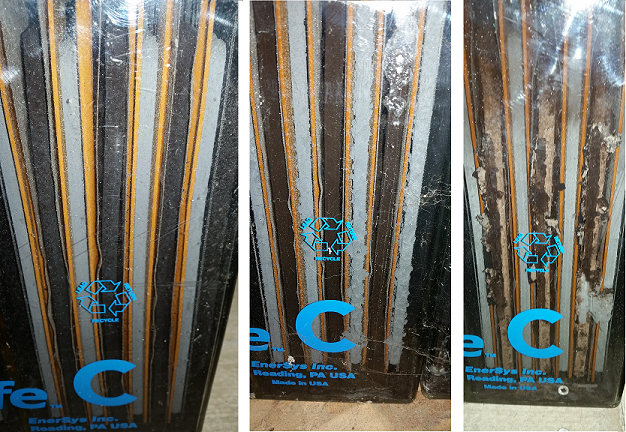
Healthy battery cell Cell needed work Dead cell
The solar panels themselves need to be turned about 4 times a year. Because we live so far north, the sun position changes in the extreme through the four seasons. In the winter the sun is south and very low, so the panels are standing almost straight up and down. During the spring and fall equinox the sun is half way up in the sky so the panels are at about a 45 degree angle to maximize solar gain. During the summer, the sun rises in the extreme north east and sets in the north west. So I lay the panels flat so that we can catch most of the energy during the summer.
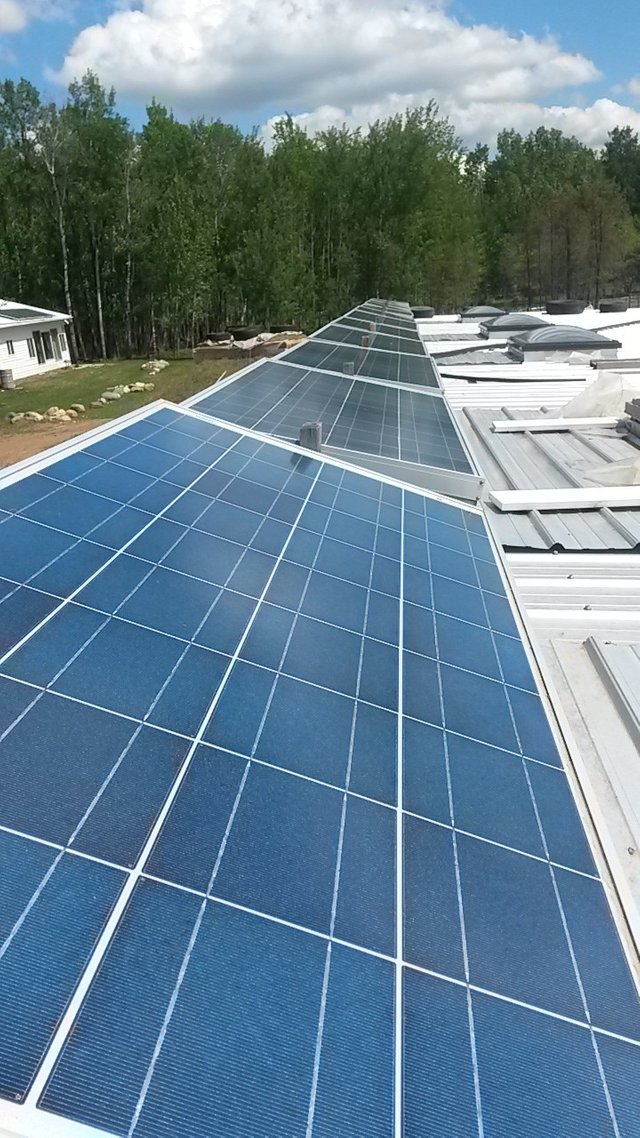
Solar panels flat for summer solar gain
Note: Solar panels drop in efficiency when warm, so a 1500W solar array in the summer will only produce about 1200W of power. But in the Winter time I've seen them produce up to 2000W when it is cold outside. I should also add that if there is a lot of cloud, smoke or other particulates in the atmosphere, this has a significant impact on how much power your array will produce. All these need to be considered when you size out your system and work with it.
Power consumption, phantom power and surges
On the back or bottom of every electrical appliance you should find a sticker or label of some kind. On this label you will see the power rating of the device. Some list the actual watts that it consumes while others list the voltage and amperage. If you multiple the volts with the amps you will get the wattage. W=VxA. So in this example, our juicer runs 120V at 2.5A which works out to 300 W (120 x 2.5 = 300).
What I have observed is that this 300W appliance does not consume 300W but is closer to 100W when I observe it running on my system. Some appliances that use motors have a surge when it first starts up. What that means is that it takes a lot of power to start the motor / pump but once it is running the power usage drops, sometimes substantially. Water pumps for example can surge to over 2000W of power but then settle down to 600 - 800W once it is running. This surge must be accounted for within your inverter, otherwise the inverter will not be able to run the appliance or pump. If there is other loads on your system it will also add up and prevent things from running as well.

Our inverter, charge controller, AC panel, DC panel and house panel.
This label is very useful if you want to calculate how much power these devices run when you are sizing up your solar system. They are also very useful if you are buying stuff for your off grid pad and want to make sure it will run fine on your system. Staying away from the very high wattage appliances will have a significant impact on your capacity to meet your needs on a daily basis.
The other thing to watch out for is phantom power. What that means is that even though something is turned off, does not mean it is not consuming power. See the red light on this picture of my TV? It is indicating that the TV is in stand by mode, even though the screen is off. What that means is that the TV is consuming power to keep it warm so that when you turn it on, it is instantly on. So even though the TV is rated at 58W, it might be consuming 40W in stand by mode. Clock radios, stoves, microwaves, etc all use power to keep the clocks, lights and buttons working. A strategy we used to avoid all these issues was to put a switch on the circuit so that we could turn the whole circuit off when not needed. In our earthship you will find a switch beside a plug in. That switch will turn off all the plugs on the circuit so that we don't drain the batteries during the night.
Generators
A lot of people I know like to get huge generators as they love to weld and work in their shop. For me, I found that huge generators don't do well with solar systems in that they consume a LOT of fuel for the amount of power that they generate. For our system and my mother-in-laws system, we found a small 2000W or 2500W generator works very well. Mom's 2000W generator is so small, she can carry it inside during the winter to keep it warm so that she can start it. It may take 4 hours to charge her system, but it only costs her a few dollars. So I recommend to people to have a small generator for charging your solar system. If you have a shop, then get a generator for it too. Charge the house while your working. Make the best use of the fuel that you do use.
One thing to remember, when running a generator, the inverter flips a switch so that the generator runs the house while the inverter charges your batteries. So if you get a generator with an inverter, then the power is much cleaner and won't mess with your electrical appliances. We love the little Honda generators that they make now. A bit more money, but they work well. Also, if you are running a small generator, you can only use that much power, otherwise you will overload the generator. So there are some balancing acts and some give & take required when running your system.
Education
The solar system will treat you well if you treat it well. Take some courses and learn how they work so that you can get the most out of the system. When building, find ways to use passive technology (not needing electricity) as possible. Active solutions require a lot of electricity and can have a negative impact on your solar system and drive up costs significantly. I also like passive solutions as they work all the time. So even if your solar system breaks, the passive solutions will just keep working! That is the one downside I have to the net zero houses that they are building now. They are so dependent on technology that if anything happens with the technology the house has major issues. With passive solutions they just keep working.
I do plan on writing an article on how to size a solar system and make sure the panels are balanced with the batteries and the loads you intend to put them under. I made myself a spreadsheet, so when I get it done I'll make it available for people to use and make the process simpler. Stay tuned, there is more info to come!

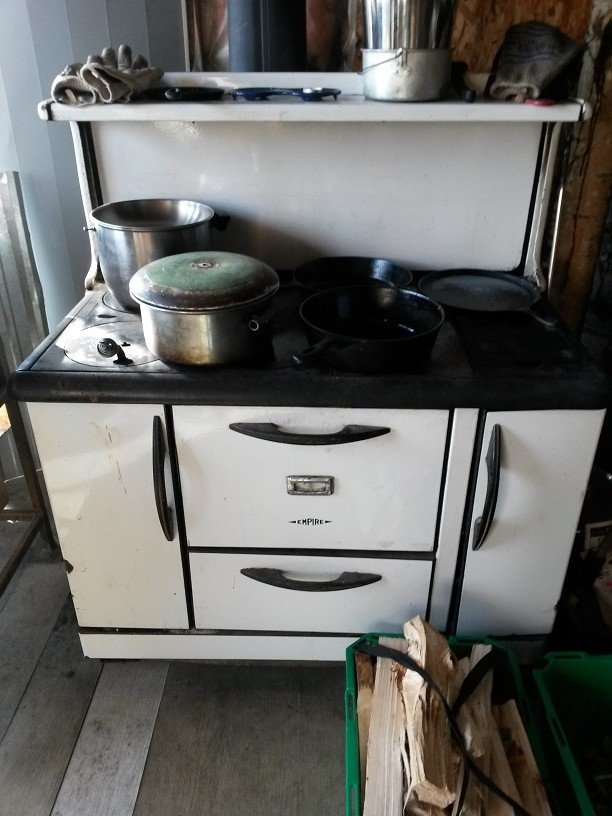
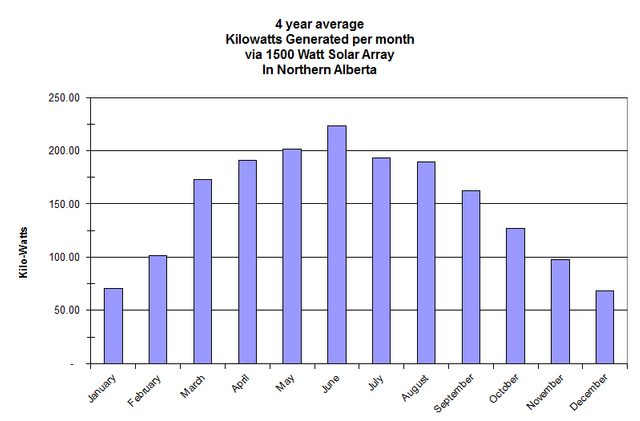

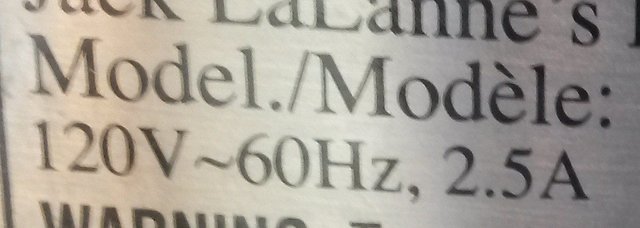
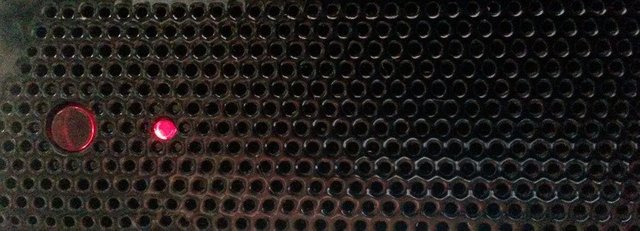
LOVELY post and such good information. Its ALL about reducing demand to make Solar power Shine! Its SO much easier to do this when you are building a new home, like an Earthship.. but CAN still be done with some changes to a modern home.
My two FAVOURITE solar friendly appliances are my Dyson Cordless Hoover and my SLow Masticating Grinder. They are a bit expensive, but work REALLY well!
These days it getting only easier to find energy efficient alternatives and other options. Once upon a time my laptop used 200 Watts and i HAD to have it on to even check my email! Now I have a 45 watt laptop that runs for hours on battery and i don't even have to turn it on nearly as much, as I use my phone for my general communications. Lights and the internet and phone are all on direct 12V with almost no power consumption. I hardly even have to turn my inverter on except for laptop charging and big appliances. I think mobile devices reduced global energy demand by a LOT when you take in to consideration the reduced laptop use, redundancy of dozens of other gadgets such as cameras and things.. and many more..'
Great post!
Thank you @eco-alex. Great to hear that other people are finding ways to get the work done with less energy. I never heard of the grinder before. We do it by hand, but I'll be looking it up as we do want to automate the process a bit when we slaughter. thanks for the tips and for sharing! Bravo!
Thanks for putting this together for us Rob, this is great. Hhaha your blog is becoming my Library :) Love it!!!
Good job @wwf. A comprehensive and well-stated article covering many aspects of solar, living with the natural cycles and using wood for cooking/heating.
I love off-grid and primitive living having done so for more than half my life.
The hardest part is not learning solar system details, but for most folks it's the transition from having all the power you want and then changing perspective to live within your systems charging capability and the battery banks' limits.
Indeed. The technical details people can look up. I just don't find many people talking about the changes and impacts the transition can have on life style. I'm glad that you enjoyed the article. Thank you for the wonderful feedback.
You are most welcome, Brother.
Our aging grid systems are starting to be tested. Like the fires now happening in Northern California. The power company admitted that extremely high winds affected the power lines and transformers, causing 17 wildfires in a 2 hour time period all within a hundred mile span.
It's best to be prepared and ahead of the trending weather extremes if the possibilities are available. Most folks probably just assume they can easily transition without much thought or planning. I feel his transition conversation is most appropriate at this time and ripe for exploration. Your thoughts?
What were/are the major challenges your family experienced going off-grid? And, of course real and possible solutions.
I agree @bilbop. I've been expressing these very same concerns on Facebook and other media for years. I think it is a critical error to depend on the grid for anything, let alone all the basic necessities of life like food, clothing, shelter, water, air, etc. When a disaster strikes, the state is there to maintain the peace rather than take actions to look after people. So they focus on control and order rather than infrastructure and distribution of aid.
As for your second question, I believe I answered that in my post on the top 6 mistakes we made when moving off the grid. I will admit that the TOP learning lesson was trusting in Creator to provide for us. We had many instances where we had zero cash but we were fine because our needs were met. However, if we needed something, the resources would appear right when we needed them. Letting go and trusting in that process was very tough and required a leap of faith.
I agree the top learning lesson is trusting in Creator. Sometimes our desires out weight our needs. LOL
I like people's posts, but I'm still new, so my upvote equates to zero right now. In time my contribution will improve. <3